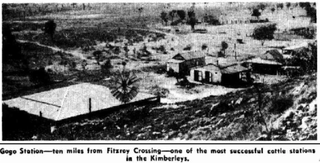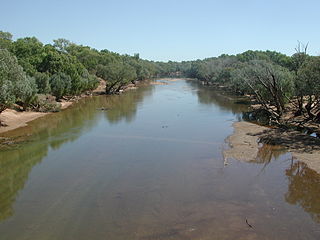Related Research Articles

The Kimberley is the northernmost of the nine regions of Western Australia. It is bordered on the west by the Indian Ocean, on the north by the Timor Sea, on the south by the Great Sandy and Tanami deserts in the region of the Pilbara, and on the east by the Northern Territory.

The Ord River is a 651-kilometre long (405 mi) river in the Kimberley region of Western Australia. The river's catchment covers 55,100 square kilometres (21,274 sq mi).

Yampi Sound is a part of the Indian Ocean off the coast of north-western Australia, in the Kimberley region of Western Australia. It is located between King Sound and Collier Bay. It lies between the Yampi Peninsula and the islands of the Buccaneer Archipelago, which contain important iron ore deposits.

The Shire of Derby–West Kimberley is one of four local government areas in the Kimberley region of northern Western Australia, covering an area of 104,080 square kilometres (40,186 sq mi), most of which is sparsely populated. The Shire's population as at the 2016 Census was almost 8,000, with most residing in the major towns of Derby, which is also the Shire's seat of government, and Fitzroy Crossing. There are also around 70 Aboriginal communities within the Shire.

King Sound is a large gulf in northern Western Australia. It expands from the mouth of the Fitzroy River, one of Australia's largest watercourses, and opens to the Indian Ocean. It is about 120 kilometres (75 mi) long, and averages about 50 kilometres (31 mi) in width. The port town of Derby lies near the mouth of the Fitzroy River on the eastern shore of King Sound. King Sound has the highest tides in Australia, and amongst the highest in the world, reaching a maximum tidal range of 11.8 metres (39 ft) at Derby. The tidal range and water dynamic were researched in 1997–1998.

Lennard River is a river in the Kimberley region of Western Australia. The river was named on 8 June 1879 by the explorer Alexander Forrest, during an expedition in the Kimberley area, after Amy Eliza Barrett-Lennard (1852-1897), who he was to marry on 15 January 1880.
The Barker River is a river in the Kimberley region of Western Australia.
The Fraser River is a river in the Kimberley region of Western Australia.

The Chamberlain River is a river in the Kimberley region of Western Australia.
The Berckelman River is a river in the Kimberley region of Western Australia.
The May River is a river in the Kimberley region of Western Australia.

The Barnett River is a river in the Kimberley region of Western Australia.
The Berkeley River is a river in the Kimberley region of Western Australia.

Gogo or Gogo Station and sometimes referred to as Margaret Downs is a pastoral lease that has operated as a cattle station. It is located about 11 kilometres (7 mi) south of Fitzroy Crossing and 83 kilometres (52 mi) north east of Yungngora in the Kimberley region of Western Australia,

Yeeda Station is a pastoral lease that operates as a cattle station in the Kimberley region of Western Australia.
George Julius Brockman was a prominent explorer and pastoralist in the Gascoyne and Kimberley regions of Western Australia.

Meda Station, often referred to as Meda River Station, is a pastoral lease in Western Australia that once operated as a sheep station but presently operates as a cattle station.
Kimberley Downs Station, commonly referred to as Kimberley Downs, is a pastoral lease that operates as a cattle station in Western Australia.

The Unggarranggu, also traditionally transcribed as Ongkarango, are an Aboriginal Australian people of the Kimberley region of Western Australia.

The Warrwa, also spelt Warwa, are an Indigenous Australian people of the Kimberley region of Western Australia.
References
- ↑ "Bonzle Digital Atlas – Map of Meda River". 2009. Retrieved 10 July 2016.
- ↑ "History of river names – M". Western Australian Land Information Authority. Retrieved 6 September 2011.
- ↑ "Modelled seabed response to possible climate change scenarios over the next 50 years in the Australian Northwest" (PDF). CSIRO. 1 March 2008. Archived from the original (PDF) on 7 September 2013. Retrieved 16 January 2014.
- ↑ "AusAnthrop Australian Aboriginal tribal database". 2012. Retrieved 6 May 2012.
Coordinates: 16°58′13″S123°49′34″E / 16.97028°S 123.82611°E